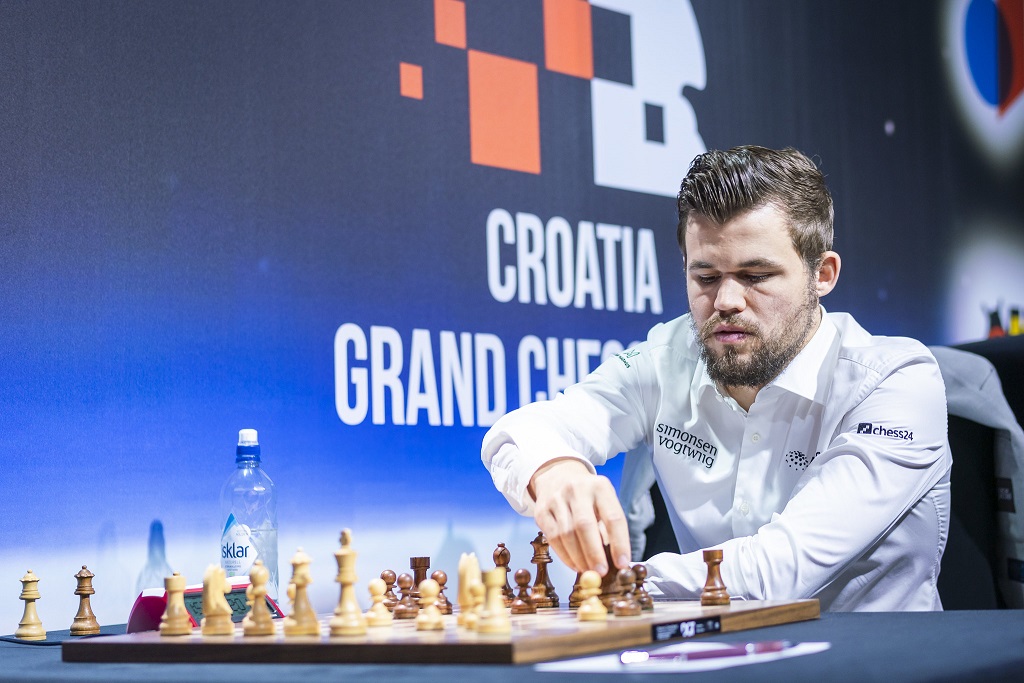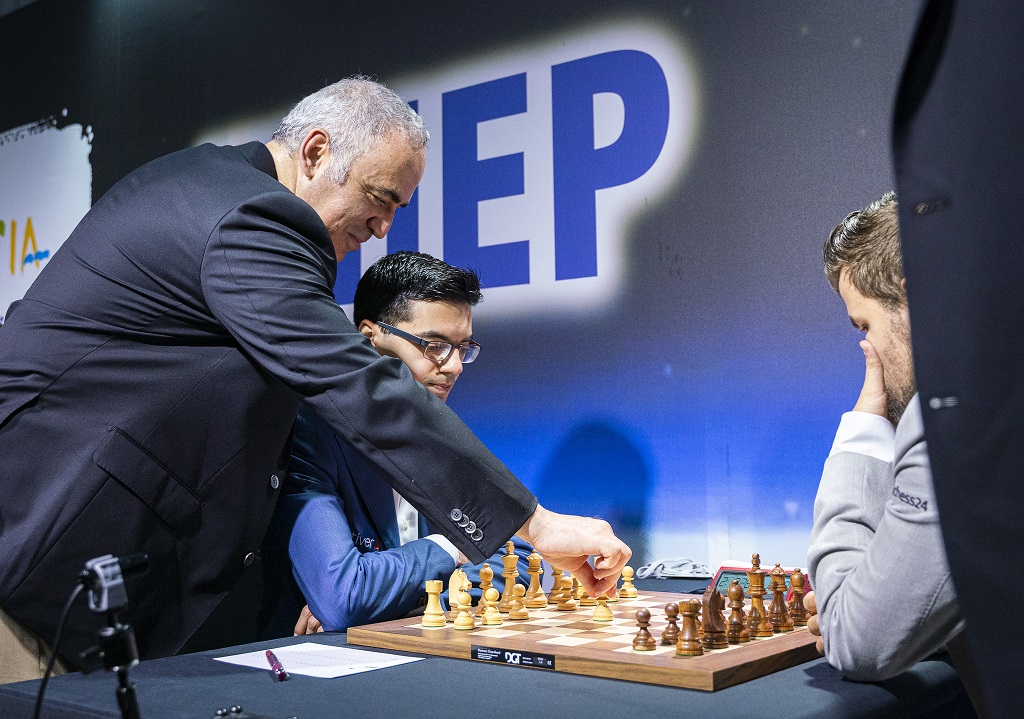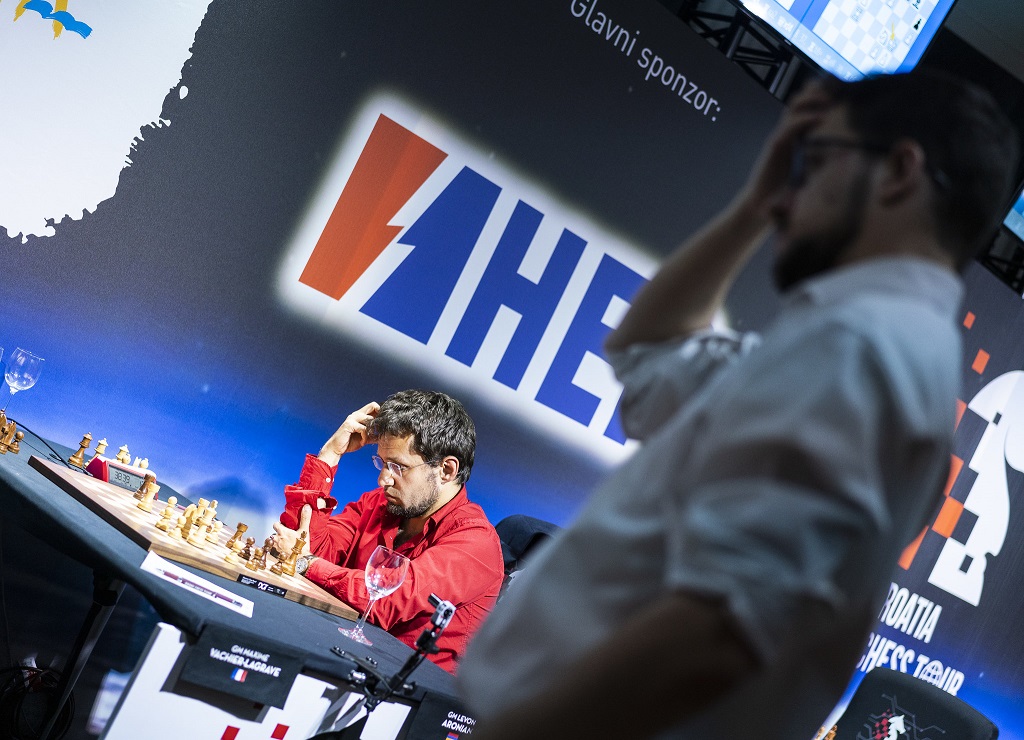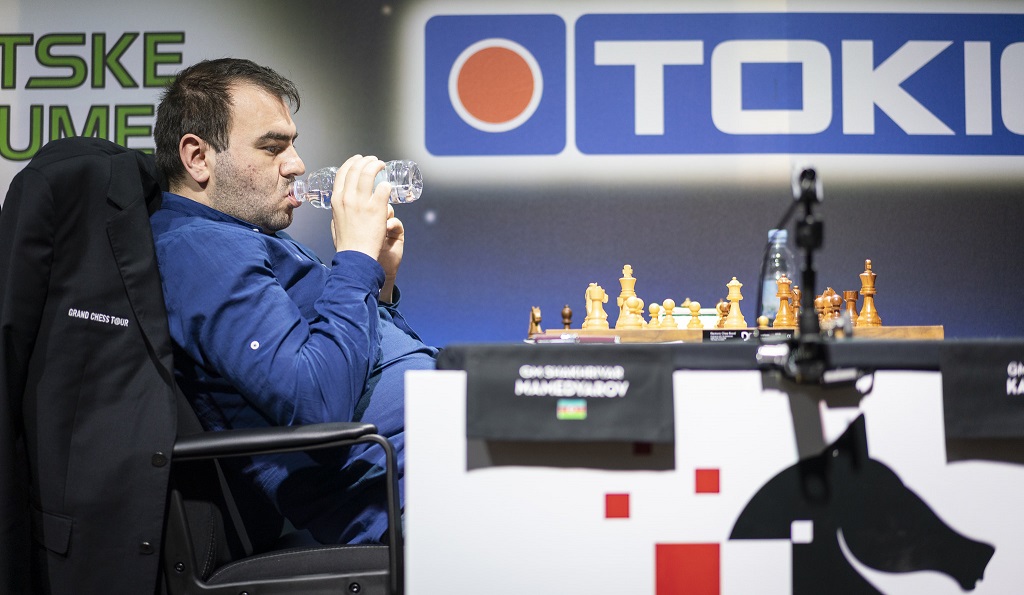


ChessBase 17 - Mega package - Edition 2024
It is the program of choice for anyone who loves the game and wants to know more about it. Start your personal success story with ChessBase and enjoy the game even more.
Magnus Carlsen has dominated the elite of the chess world for about half a year already, winning the last seven tournaments he has attended. Before that, he had successfully defended the World Championship title in London but, due to the twelve draws signed in classical chess during his match against Fabiano Caruana, there were doubts regarding his supremacy in slow time controls. His triumphs in Wijk aan Zee, Shamkir and Baden-Baden, however, proved the naysayers wrong. For him, only first place seems to be of significance, and it will be tough to keep up the pace in Zagreb.
In round one, the world champion was one of four players to start with a win, which means he now shares first place with Wesley So, Ian Nepomniachtchi and Fabiano Caruana.

Former world champion Garry Kasparov was in the premises, and he played Anish Giri's 1.e4 | Photo: Lennart Ootes / Grand Chess Tour
Against Giri, the Norwegian unsurprisingly played the Sicilian with Black, and adopted a rarely used approach as early as move seven:
Master Class Vol.8: Magnus Carlsen
Scarcely any world champion has managed to captivate chess lovers to the extent Carlsen has. The enormously talented Norwegian hasn't been systematically trained within the structures of a major chess-playing nation such as Russia, the Ukraine or China.
Carlsen's 7...d6 was only tried once in the past, by Alexei Fedorov against Alexander Motylev during last year's European Championship. The world champion explained afterwards that he chose this setup as it was unlikely for his opponent to have prepared against it. And, indeed, Giri spent over seventeen minutes on 8.exd6.
White's position was not inferior at all, but clearly Black was the one better prepared to deal with the complications. By the fifteenth move, Carlsen already had a big edge on the clock, which perhaps prompted Giri to go for an unnecessarily passive continuation:
You can replay the game moves and try your own on the diagram above
With 16.♘e2, White is trying to deal with the 'threat' of Black putting his knight on d4, when active alternatives such as 16.♖d1 or 16.♗e3 were called for. The game continued 16...♜c8 17.♕a4 ♜c7 18.♗f4 ♜d7 19.c3.
Advancing the c-pawn with 19.c3 simply allowed Black to mobilize his kingside majority. After 19...g5 20.♖ad1 ♜xd1 21.♖xd1, Carlsen played 21...♛a8 — the move Giri later declared he had missed — and resignation came after 22.♗c7 h4 23.f3 h3.
Black's queen is on the long diagonal, the rook on the h-file is about to come alive and the knight is ready to wreak havoc around White's king: 0-1.
Special guest Garry Kasparov was among those in Zagreb who lauded Carlsen's "deep understanding of chess":
How I became World Champion Vol.1 1973-1985
Garry Kasparov's rise to the top was meteoric and at his very first attempt he managed to become World Champion, the youngest of all time. In over six hours of video, he gives a first hand account of crucial events from recent chess history, you can improve your chess understanding and enjoy explanations and comments from a unique and outstanding personality on and off the chess board.

Anish Giri looking at Magnus Carlsen's post-game interview with Maurice Ashley | Photo: Lennart Ootes / Grand Chess Tour
The all-American battle of round one featured the highest-rated player from the United States, Fabiano Caruana, against the current US champion, Hikaru Nakamura. Caruana had the white pieces and the players quickly repeated no less than eighteen moves from two previous encounters between Levon Aronian and Nakamura (the American held Aronian to a draw with Black both at the 2017 London Chess Classic and the 2018 Norway Chess Tournament). This fact makes it all the more surprising that Nakamura was the one to go astray subsequently:
Winning Structures by GM Adrian Mikhalchishin
Great players always had and still have more than just broad theoretical knowledge. Every of them has some favourite methods, which simply help to score more points. The greatest even have favourite pawn structures! And they immediately exploited the knowledge of others - Alekhine invented some interesting structures, which were copied by his opponent in that game (Rubinstein), and later exploited by Botvinnik and then by Kramnik!
While Aronian had chosen to castle kingside with White on move 19, Caruana now left his king in the centre, which means Black really needed to think it twice before going for 24...♛xa3. The problem is that White has now gained a tempo to keep improving his pieces on the kingside — Black should play 24...♞g5, focusing on the dangerous flank of the board. Caruana continued with 25.♖h4 and Black was already in deep trouble.
Black gave some checks with his queen, but White's king safely hid on f1. The rest of the game was played flawlessly by Caruana, who, much like Carlsen, effectively used his h-pawn to crash through:
The next four moves by White were 37.h6, 37.♖d6 (with tempo), 38.♖e6 and 39.♖ee7, doubling on the seventh rank and provoking his opponent's resignation.

Fellow countrymen Fabiano Caruana and Hikaru Nakamura discuss their first round encounter | Photo: Lennart Ootes / Grand Chess Tour
Wesley So and Ian Nepomniachtchi arrived in Zagreb after having good performances in Stavanger and Moscow. The American gained a little over nine points in the classical ratings list at the Norway Chess tournament by drawing eight games and beating Yu Yangyi, while the Russian took down Alexander Grischuk in the final match of the Moscow Grand Prix — Nepomniachtchi is currently the clear number one in Russia.
In round one, So defeated none other than Ding Liren after the latter gave up the bishop pair in the opening, thus accepting to go into a position with strategical minuses. So turned up the pressure slowly, until eventually Ding allowed him to trap his light-squared bishop:
Opening package: 1.b3 and Black Secrets in the Modern Italian
Wesley So published two new opening DVDs: 1.b3, the so called Nimzo-Larsen-Attack, for White and his black secrets in the modern Italian. Get them in a package and save money!
Black's bishop is out of squares to escape if it gets attacked, thus it was necessary to create a path to freedom with a move like 29...♛d7. Instead, Ding opted for 29...♜c8 and lost the piece after 30.♖c3 ♝g4 31.f3 b4 32.♖d3 ♝xf3.
The number one from China tried to create confusion by exchanging a rook and a knight for White's queen, but the material advantage was already too big to be neutralized. The score sheets were signed with 1-0 as the result after 50 moves.

Wesley So took down number three in the world | Photo: Lennart Ootes / Grand Chess Tour
Meanwhile, Vishy Anand and Nepomniachtchi were fighting in a position that arose from an Italian Opening. White's king was in the centre but Black's pawn structure in front of his own king was also highly weakened. Nepomniachtchi dealt with the challenges presented by the position better than his opponent and wound up with the more active pieces.
In the actual DVD Bologan covered all answers by Black against 3.Bc4, especially 3...Bc5, presenting all relevant possibilities for White.
Black's pieces are all in play or in position to join the fray, while White's rooks are not connected, Black's dark-squared bishop prevents him from castling and White's minor pieces are rather clumsily distributed. It was time for Anand to limit the damage by exchanging pieces with 30.♘xf5, but the Indian went for 30.♗e2 instead. Nepomniachtchi kept on improving his army with 30...♜h6 and 31...♝c6, while Anand could only shuffle his rook with 31.♖h2 and 32.♖g2. It is no wonder, therefore, that the former world champion resigned after 32...♞d6.

'Not bad' seems to be thinking Ian Nepomnachtchi | Photo: Lennart Ootes / Grand Chess Tour
The draws of the day were signed in Maxime Vachier-Lagrave vs Levon Aronian, after the players tried to create imbalances during 50 moves out of a Berlin Defence, and in Shakhriyar Mamedyarov vs Sergey Karjakin, a 27-move draw which featured some flashy preparation.

Good old friends Maxime Vachier-Lagrave and Levon Aronian explored the Berlin Defence | Photo: Lennart Ootes / Grand Chess Tour

There was some talk about the high temperature in the playing hall — Shakhriyar Mamedyarov remained hydrated | Photo: Lennart Ootes / Grand Chess Tour
Commentary by GM Yasser Seirawan, IM Jovanka Houska and GM Alejandro Ramirez